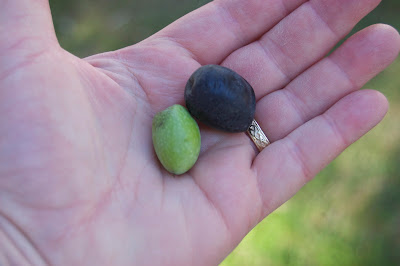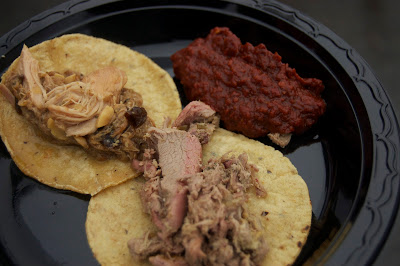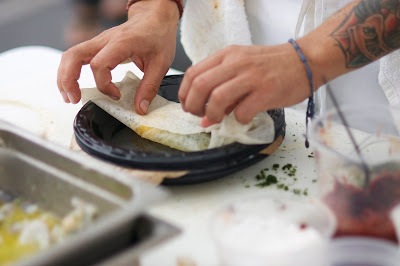Some years Thanksgiving involves a big ol’ celebration with loads of people, but this has been such a busy autumn for us, with too much out-of-towning, that Himself and I decided on a quiet meal at home alone this time. Since I’m not a traditionalist when it comes to Thanksgiving, I refuse to succumb to the pressure most everyone else feels to have turkey. Himself is just fine with this stance, so instead we celebrated with one of our favorite dishes, duck confit and fingerling potatoes roasted in duck fat. That not only satisfied the desire for something rich and tasty for Thanksgiving, but it also provided the month’s self-assigned blog entry on a type of game or exotic meat.
Rather than roast a whole duck, we opted to break into a cache of duck legs cooked and stored in their own fat, the traditional Gascon way of preserving meat. As with last month’s pheasant, we didn’t have to contend with buckshot, because we did our hunting in a local French import warehouse that opens its doors to the civilian population a few times a year, usually the weekend before a holiday or special occasion. There we loaded up on confit, cheeses, olives, olive oil and a few other treats. It’s great getting to pick up a package of six duck legs for what we’d typically pay to order a modest portion in a restaurant. While the package of confit contained a good deal of fat, we grabbed a jar of duck fat, too, which should keep us in rich, tasty meals long after we’ve polished off the last of the duck legs.
Since the duck is cooked during the confit process, it was essentially ready to eat right out of the package–but so much better when we applied some serious heat to it in a ripping hot pan with the melted fat. This not only warmed the meat but gave it a nice, crispy skin to crunch into.
With all that fat and dark meat, we decided on a pair of accompanying dishes that would be healthy companions to the oh-my-gawd richness of the duck and potatoes. So we double-cooked some kale, first boiling it first and then giving it a light sauté with red onion and garlic, and sassing it up with red wine vinegar and some red pepper flakes.
And we tossed slices of oranges and roasted beets with slivers of onion and shallot, olive oil and red wine vinegar to make an amazing salad that just kept getting better and better–and more and more neon!–every time we pulled the leftovers out of the fridge. It was practically dessert, and that was a good thing, because we didn’t actually plan a dessert for this meal.
I wish I could regale you with stories of a grand Thanksgiving dessert to cap the meal, but we were so full that we just didn’t want one. Pumpkin pie? Frankly, it’s never been a favorite around here. Pecan pie? Love it, but it just wasn’t in the cards this time. So we went for a few drops each of The Good Stuff, which is both a lovely treat and a fine digestif: extra vecchio balsamico from our last trip to Italy. It’s truly amazing how satisfying that can be, how the tang cleanses the mouth and the earthy sweetness satisfies the urge for a dessert finish to the meal.
So I’m thankful:
♦ for the bounty of the farmers’ market that provided the seasonal beets, kale and potatoes.
♦ that we didn’t feel we had to tie ourselves to tradition and cook someone else’s version of the perfect Thanksgiving feast. The tradition we DID embrace this time was the Gascon tradition of preserving duck so that it can be quickly and easily prepared and enjoyed–and I’m thankful for that, too.
♦ for the luxury of the balsamico, which was a treat indeed; and
♦ for Himself, who understands and appreciates my enthusiasm for bucking traditions and doing things differently. This has enabled us to enjoy past Thanksgivings shared with friends as we celebrated the holiday with menus as varied as last year’s Croatian feast and the previous year’s spread of comfort foods from our home turf of Tennessee.
Later in the evening, too close to bedtime to eat another meal but far away from breakfast not to eat a little something, we settled on a simple dessert to cap off the day, vanilla ice cream with a drizzling of the balsamico. Then with nothing more on our minds at bedtime than mulling over the possibilities for how we wanted to prepare those remaining three duck legs, we purred ourselves to sleep. A nice cassoulet perhaps?…
























